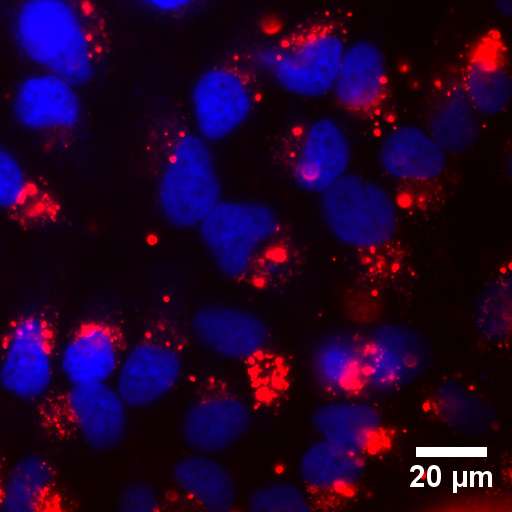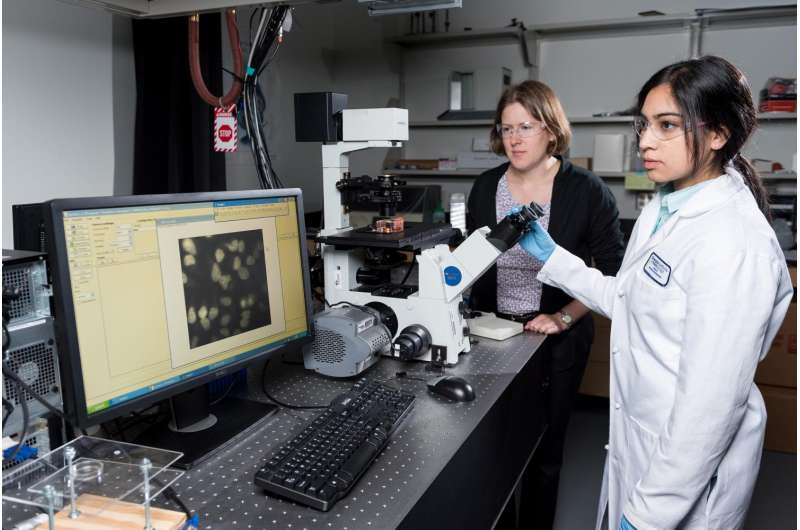Common nanoparticle has subtle effects on oxidative stress genes

A nanoparticle commonly used in food, cosmetics, sunscreen and other products can have subtle effects on the activity of genes expressing enzymes that address oxidative stress inside two types of cells. While the titanium dioxide (TiO2) nanoparticles are considered non-toxic because they don't kill cells at low concentrations, these cellular effects could add to concerns about long-term exposure to the nanomaterial.
Researchers at the Georgia Institute of Technology used high-throughput screening techniques to study the effects of titanium dioxide nanoparticles on the expression of 84 genes related to cellular oxidative stress. Their work found that six genes, four of them from a single gene family, were affected by a 24-hour exposure to the nanoparticles.
The effect was seen in two different kinds of cells exposed to the nanoparticles: human HeLa cancer cells commonly used in research, and a line of monkey kidney cells. Polystyrene nanoparticles similar in size and surface electrical charge to the titanium dioxide nanoparticles did not produce a similar effect on gene expression.
"This is important because every standard measure of cell health shows that cells are not affected by these titanium dioxide nanoparticles," said Christine Payne, an associate professor in Georgia Tech's School of Chemistry and Biochemistry. "Our results show that there is a more subtle change in oxidative stress that could be damaging to cells or lead to long-term changes. This suggests that other nanoparticles should be screened for similar low-level effects."
The research was reported online May 6 in the Journal of Physical Chemistry C. The work was supported by the National Institutes of Health (NIH) through the HERCULES Center at Emory University, and by a Vasser Woolley Fellowship.
Titanium dioxide nanoparticles help make powdered donuts white, protect skin from the sun's rays and reflect light in painted surfaces. In concentrations commonly used, they are considered non-toxic, though several other studies have raised concern about potential effects on gene expression that may not directly impact the short-term health of cells.
To determine whether the nanoparticles could affect genes involved in managing oxidative stress in cells, Payne and colleague Melissa Kemp - an associate professor in the Wallace H. Coulter Department of Biomedical Engineering at Georgia Tech and Emory University - designed a study to broadly evaluate the nanoparticle's impact on the two cell lines.
Working with graduate students Sabiha Runa and Dipesh Khanal, they separately incubated HeLa cells and monkey kidney cells with titanium oxide at levels 100 times less than the minimum concentration known to initiate effects on cell health. After incubating the cells for 24 hours with the TiO2, the cells were lysed and their contents analyzed using both PCR and Western Blot techniques to study the expression of 84 genes associated with the cells' ability to address oxidative processes.
Payne and Kemp were surprised to find changes in the expression of six genes, including four from the peroxiredoxin family of enzymes that helps cells degrade hydrogen peroxide, a byproduct of cellular oxidation processes. Too much hydrogen peroxide can create oxidative stress which can damage DNA and other molecules.
The effect measured was significant - changes of about 50 percent in enzyme expression compared to cells that had not been incubated with nanoparticles. The tests were conducted in triplicate and produced similar results each time.

"One thing that was really surprising was that this whole family of proteins was affected, though some were up-regulated and some were down-regulated," Kemp said. "These were all related proteins, so the question is why they would respond differently to the presence of the nanoparticles."
The researchers aren't sure how the nanoparticles bind with the cells, but they suspect it may involve the protein corona that surrounds the particles. The corona is made up of serum proteins that normally serve as food for the cells, but adsorb to the nanoparticles in the culture medium. The corona proteins have a protective effect on the cells, but may also serve as a way for the nanoparticles to bind to cell receptors.
Titanium dioxide is well known for its photo-catalytic effects under ultraviolet light, but the researchers don't think that's in play here because their culturing was done in ambient light - or in the dark. The individual nanoparticles had diameters of about 21 nanometers, but in cell culture formed much larger aggregates.
In future work, Payne and Kemp hope to learn more about the interaction, including where the enzyme-producing proteins are located in the cells. For that, they may use HyPer-Tau, a reporter protein they developed to track the location of hydrogen peroxide within cells.
The research suggests a re-evaluation may be necessary for other nanoparticles that could create subtle effects even though they've been deemed safe.
"Earlier work had suggested that nanoparticles can lead to oxidative stress, but nobody had really looked at this level and at so many different proteins at the same time," Payne said. "Our research looked at such low concentrations that it does raise questions about what else might be affected. We looked specifically at oxidative stress, but there may be other genes that are affected, too."
Those subtle differences may matter when they're added to other factors.
"Oxidative stress is implicated in all kinds of inflammatory and immune responses," Kemp noted. "While the titanium dioxide alone may just be modulating the expression levels of this family of proteins, if that is happening at the same time you have other types of oxidative stress for different reasons, then you may have a cumulative effect."
More information: Sabiha Runa et al, TiONanoparticles Alter the Expression of Peroxiredoxin Antioxidant Genes, The Journal of Physical Chemistry C (2016). DOI: 10.1021/acs.jpcc.6b01939
Journal information: Journal of Physical Chemistry C
Provided by Georgia Institute of Technology


















